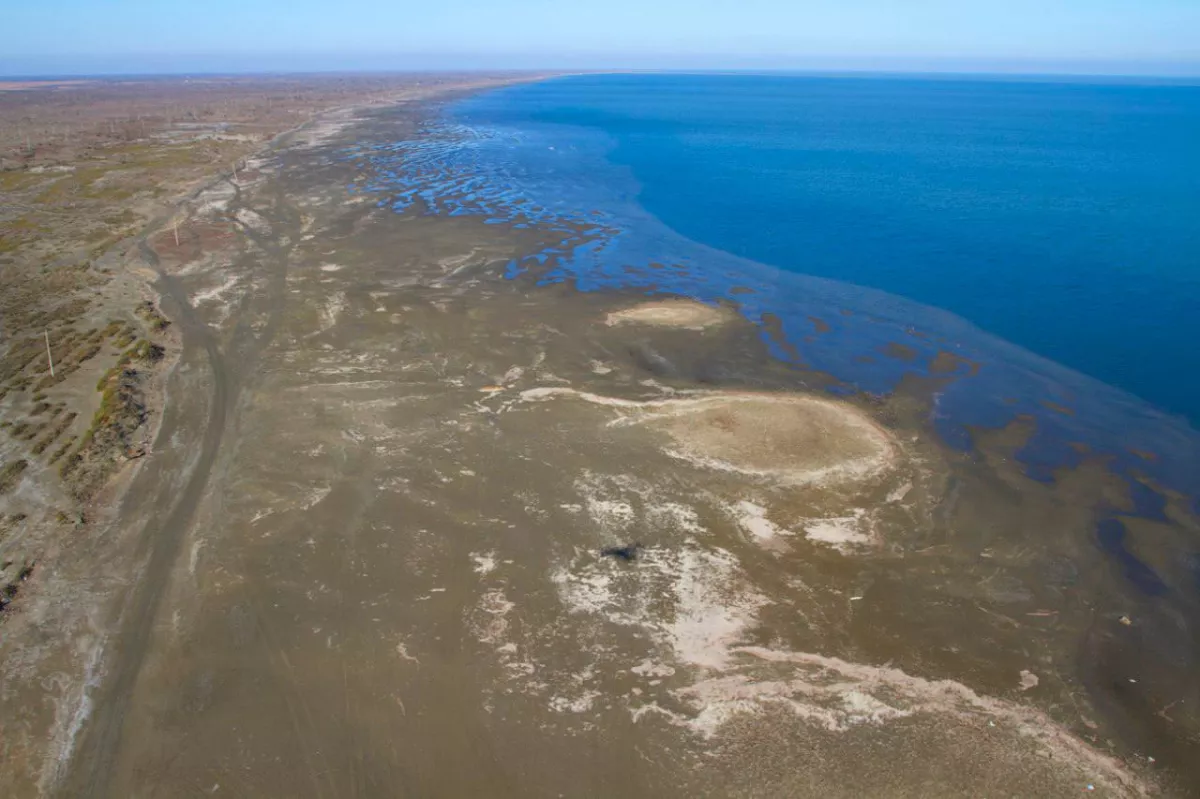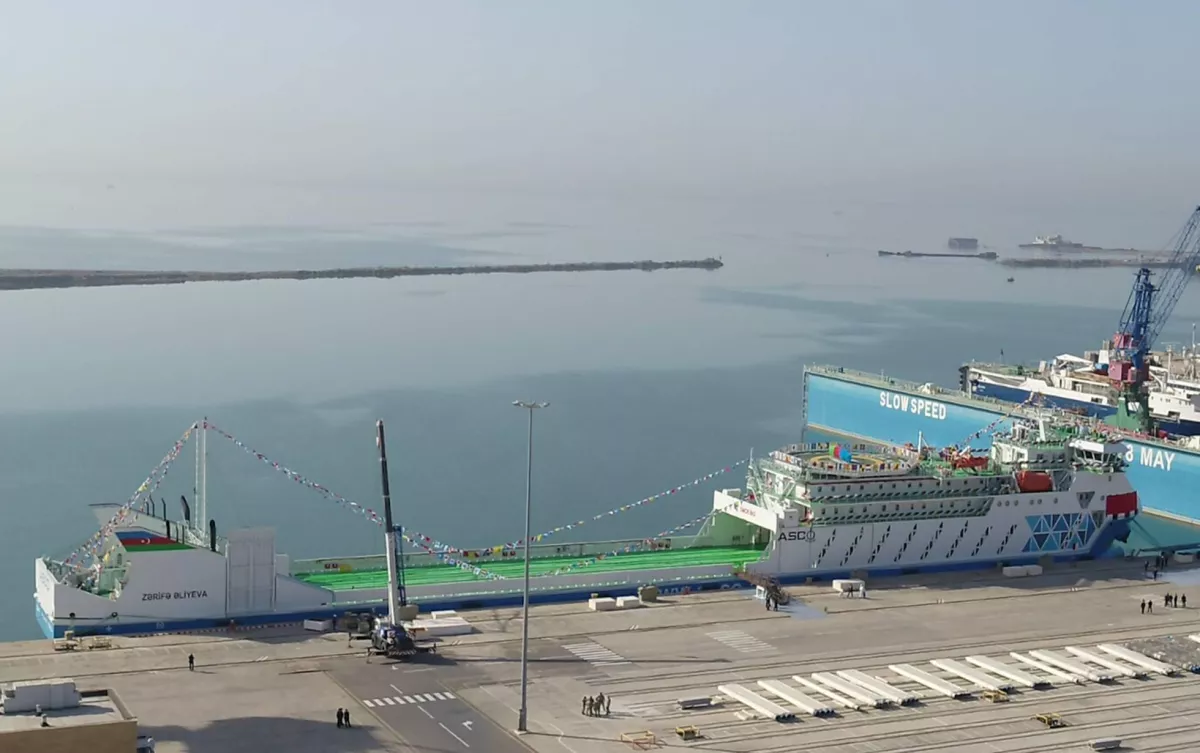Caspian ports to deepen fairways amid falling sea levels Thirty feet under the keel
The nearly quarter-century-long decline in the Caspian Sea level continues to raise concerns among the littoral states. Climate change — rising temperatures and shifting wind patterns — as well as man-made factors such as the reduced flow of the main rivers feeding the Caspian basin, are the key causes of water loss.
The most challenging situation has developed in the shallower northern part of the sea, hampering navigation in Russian and Kazakh ports. To mitigate losses, Russia has planned the construction of a relief fairway along a section of the Volga–Caspian Canal, while dredging works are underway in Kazakhstan’s ports of Aktau and Kuryk. Azerbaijan’s ports of Alat, Dubendi, and the “Baku Shipyard” zone are also systematically maintained in working condition, with the country building and purchasing dredging vessels.
Over the past two decades, the Caspian Sea level has been dropping by an average of 20 cm per year, with its surface area shrinking by more than 23,000 sq. km. Unfortunately, in recent years these processes have accelerated noticeably due to more frequent droughts, higher evaporation rates, and the lack of natural replenishment from precipitation and river inflows.
“From 1996 to the present, the Caspian Sea level has fallen by 2.3 metres, and this process continues. The main cause is a change in the water balance. The Caspian is a closed basin fed primarily by river inflows. However, due to global climate change, water temperatures have risen, and evaporation has accelerated significantly. This is further compounded by the declining water levels in the rivers flowing into the basin,” said Professor Amir Aliyev, Doctor of Geographical Sciences and head of the Department of Coastal and Seabed Geomorphology of the Caspian Sea at the Institute of Geography named after academician Hasan Aliyev, in a recent interview with local media.
According to the scholar, until 1930 the Caspian’s water level remained relatively stable. From then until 1978, the sea level fell by 3.2 metres, followed by a reverse trend between 1978 and 1995, when the water level rose by 2.5 metres, causing coastal flooding. Notably, monitoring conducted over the past three years indicates that the rate of decline has slowed: whereas previously the annual drop measured 25–30 cm, it is now 15–17 cm.
In addition to global climatic processes and the natural cyclicity of the Caspian Sea — the periodic rise and fall of water levels — anthropogenic and technogenic factors also play a role. The main one is the regulation of the Russian Volga River, which supplies about 85% of the Caspian’s total inflow. As far back as the Soviet period, nine major reservoirs were built along the Volga, and in recent years excessive water withdrawal for agricultural irrigation and municipal needs has been observed. Altogether, these factors have led to a 25–30% reduction in the inflow and precipitation reaching the Caspian Sea. Similar processes linked to excessive water extraction have also been recorded in the other two key rivers of the Caspian basin — the Ural and the Kura.

“Over the past decade, the Caspian Sea has lost up to two metres in water level, and according to our climatologists’ estimates, the decline will continue for at least another 3–5 years. Undoubtedly, these are highly critical processes for the region,” noted Igor Shumakov, head of Roshydromet, during the recently concluded session of the Caspian Sea Hydrometeorology Coordination Committee in St. Petersburg.
Turkmenistan and Iran, located along the deeper southern part of the basin, have been less affected by the shallowing of the sea. Nevertheless, the problem impacts all five Caspian littoral states to varying degrees, affecting port operations, reducing the efficiency of navigation, and damaging the sea’s ecosystem.
“The retreat of the coastline changes natural conditions, disrupts economic activity and creates new challenges for sustainable development,” Azerbaijan’s Deputy Minister of Ecology Rauf Hajiyev recently told Reuters. According to him, oil shipments through the Dubendi terminal fell to 810,000 tonnes in the first half of 2025, compared with 880,000 tonnes a year earlier. Large-scale dredging work has been required to maintain the port’s throughput capacity. The deputy minister also highlighted the threats posed to ecosystems by the shallowing: sturgeon are losing up to 45% of their summer and autumn habitats, deprived of traditional spawning grounds, while risks have also increased for the Caspian seal population.
In early August of this year, the Turkmen city of Awaza hosted the Third UN Conference on Landlocked Developing Countries. During the forum, representatives of Caspian littoral states once again raised the issue of closer coordination to mitigate the negative consequences of the Caspian Sea’s shallowing. They initiated the launch of a multilateral cooperation mechanism designed to establish common standards and approaches to studying the processes taking place in the Caspian Sea.
Speaking at the conference, Azerbaijan’s Deputy Prime Minister Shahin Mustafayev stressed that the decline in sea level is a matter of regional concern. He recalled that Azerbaijan’s President first raised this issue at the Ashgabat Summit in 2022, and preparations are now underway to hold the inaugural meeting of a five-party expert group in Baku. The deputy prime minister also emphasised the need to expand research cooperation and implement joint programmes in fisheries, navigation, and biodiversity conservation to minimise the adverse effects of changing sea levels.
At the same time, alongside bolstering scientific research, the Caspian littoral states are taking concrete steps to mitigate the impact of the sea’s shallowing. In Russia, dredging has been carried out in recent years along the Volga–Caspian Sea Shipping Canal (VCSSC), which runs through the shallow delta in the Astrakhan Region, ensuring safe passage for vessels with a draft of 4.5 metres or more. By 2027, Rosmorport, with support from Rosmorrechflot, plans to construct a new relief fairway along the most challenging section of the VCSSC.
Meanwhile, Kazakhstan’s KazMunayGas (KMG) and Russia’s LUKOIL will build a seaway canal through the Ural Saddle in the Caspian Sea to service the Kalamkas-Sea and Khazar oil fields.
Notably, in recent years, Kazakhstan’s ports of Aktau and Kuryk have seen a sharp decline in shipping performance due to the Caspian Sea’s decreasing depth. Around two years ago, water depths in the ports’ access channels fell to 4.9 metres, compared with the navigational standard of 6.11 metres. Consequently, ship loading at these ports has dropped to less than 75% of their available deadweight capacity. To address these challenges, the Kazakh government estimates that approximately 40 billion tenge (about 72 million US dollars) will be needed for dredging operations.
“At the Port of Aktau, oil tankers and dry cargo vessels are being underloaded due to the Caspian Sea’s declining level. Tankers with a capacity of 12,000 tonnes are loading only up to 10,000 tonnes, while dry cargo ships are underloaded by 300–400 tonnes,” said Abay Turikpenbaev, Chairman of the Aktau Commercial Sea Port, in April at the Caspian and Central Asia Oil, Trade, and Transport Forum in Baku. “We plan to deepen the port to 7.7 metres, which will allow vessels to load fully. This is just the first stage, ensuring stable operations over the next 3–4 years.”
Notably, by November of last year, dredging at the Port of Kuryk was completed in record time, with the water area and access channel reaching 7–8 metres, enabling vessels to load to full capacity upon arrival. Since June of this year, similar dredging operations have been underway at the Port of Aktau.
Overall, as Kazakhstan’s Minister of Transport, Nurlan Sauranbaev, recently noted, addressing bottlenecks along the Trans-Caspian International Transport Route (TITR) will require $18 billion. Port modernisation has been classified as an urgent priority, as the route’s throughput is expected to rise from 4.5 million tonnes in 2024 to 10 million tonnes by 2027.

Unlike its regional neighbours, Azerbaijan has been comparatively less affected by the Caspian Sea’s shallowing in terms of the functionality of its main maritime port areas. It is worth recalling that during the construction of the Baku International Sea Trade Port (BISTP) as early as July 2011, extensive earthworks and dredging operations were carried out in advance with the involvement of the Dutch contractor Van Oord Dredging and Marine Contractors B.V. As a result, using modern equipment and advanced technologies, a 7 km-long, 160-metre-wide fairway with a depth of 7.6 metres was created in the entrance channel and manoeuvring area of the port’s maritime section.
Thanks to systematic maintenance of the Alat Port’s waterways, fairway depths have generally been maintained between 7.5 and 6.9 metres. This allows large-draft vessels operating in the Caspian Sea to berth at BISTP without restrictions. The port, one of the most modern and deep-water facilities on the Caspian, also conducts regular bathymetric surveys using state-of-the-art equipment, and vessel traffic areas are kept under continuous monitoring.
To prevent the Caspian Sea’s shallowing from negatively affecting operations at the Dubendi maritime oil terminal, necessary dredging works have been carried out there. Under constant supervision is also a small dry cargo port established in March 2010 near the Zykh Spit, which includes storage facilities and 10 berths.
Meanwhile, in July, Azerbaijan Caspian Shipping Company (ASCO), part of AZCON Holding, successfully completed dredging works in the water area and access channel of the Baku Shipyard. The project covered an area of 80,000 square metres, increasing the seabed depth by 1 metre, bringing the overall depth of the water area to 9 metres. Over the course of approximately three months, the project created favourable hydrographic conditions for the safe manoeuvring and berthing of large-tonnage vessels at the shipyard.
In any case, given scientists’ forecasts of a potential further decline in the Caspian Sea level, there will be a need to deepen fairways in domestic ports. Proactive measures have already been taken since 2023, including the procurement of modern dredging equipment.
In particular, on 11 April 2025, the Baku Shipyard, with the support of the Dutch company Damen Shipyards Gorinchem B.V., launched the dredger Engineer Soltan Kazimov. This 535-ton vessel, 61.2 metres in length, is equipped with a 700 kW cutter head designed for dredging at depths of up to 18 metres. It features a separate-section refuelling pump, and the vessel’s total installed power is 2,972 kW, allowing it to process approximately 7,000 cubic metres of sediment mixture per hour. This year, the vessel’s work will focus on deepening fairways in Azerbaijan’s ports, ensuring service for ships with drafts of 6–8 metres, such as 8,000-tonne tankers.
Additionally, in the first half of 2025, Azerbaijan imported two dredgers from the Netherlands and China at a total cost of $11.6 million.








